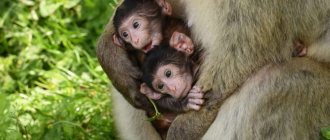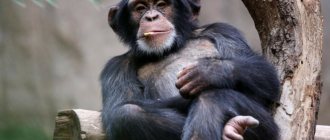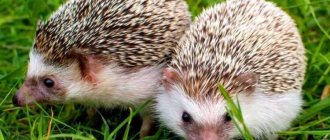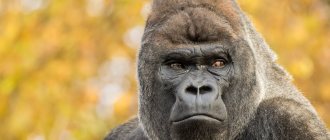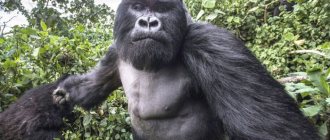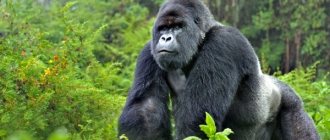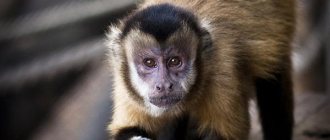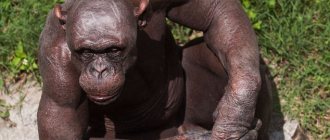Monkeys are mammals that have both legs and arms, therefore, in the anatomical structure of their body, they are similar to humans. In fact, they are called four-armed mammals. In addition, all monkeys are included in the order of primates. Nowadays, monkeys have a slightly different classification, therefore they are classified in the infraorder “Ape-like”, along with tarsiers. In this regard, they belong to the suborder “Dry-nosed primates”. All species of prosimians (with the exception of tarsiers) are represented by the suborder “Wet-nosed primates”
Description
Monkeys are characterized by the presence of a complex and fairly well-developed brain structure, which determines their intellectual inclinations.
This applies to a greater extent to monkeys, classified as anthropoids. They have a section in their brain whose functional purpose is to produce meaningful movements. Most species of monkeys have binocular vision, which means they can see objects in front of them with both eyes at the same time. They have a dental system similar to humans, which may differ slightly from species to species. Apes have large teeth and a developed root system.
Monkeys have fangs characteristic of predators
Unlike humans, whose white eye whites contrast with their pupils, monkeys have dark eye whites combined with black pupils.
Only New World monkeys have prehensile tails.
Only New World monkeys from the spider monkey family, such as howler monkeys and koats, and capuchins from the cebid family have prehensile tails. They are able to support the weight of the animal's body and help it grasp objects. These special tails, with ridges on the underside, are so flexible that they can lift very small objects as small as peanuts! Old World monkeys have tails, but they are not prehensile, and macaques are almost tailless.
In terms of length and grasping ability, spider monkeys are superior to capuchins. Spider monkeys have hairless tails that are longer than their bodies. They also have friction pads for improved grip. Capuchins have relatively short tails covered with hair. They are mainly used for grasping branches and carrying food.
Appearance
The species of monkeys is very diverse and differs based on the primates belonging to specific species. For example, there are species whose weight does not exceed 150 grams. Also among the monkeys there are those whose weight reaches more than 300 kilograms. This also determines the body length of monkeys. Thus, in pygmy marmosets this figure is no more than 15 cm, while male gorillas can reach a body length of more than two meters.
Adult male gorilla
The peculiarities of the monkeys' way of life (constant stay in trees) determine their physiological structure: a long back, a narrow, short chest and fairly light bones.
There are species of monkeys that are characterized by the presence of a long tail that exceeds the size of the body. With the help of such a tail, they control movement along tree crowns. Thus, the long tail plays the role of a kind of rudder, helping to jump and move more easily.
Elena
Ask a Question
Question to the expert
Can monkeys swim?
It has long been believed that monkeys are afraid of water, which has led to zoos using water moats as artificial barriers to separate spaces. However, during experiments, this theory was completely refuted by scientists: Renato Bender and Nicole Bender revealed that the ability to swim is inherent at the genetic level, but due to its uselessness it was not used for a long time. This happened because the monkeys were more comfortable moving on land using their limbs rather than crossing bodies of water. As a result of the experiment, it was proven that monkeys can swim and dive at depth. Moreover, unlike other mammals, which do it like a dog, monkeys have a swimming style similar to humans, as they do it with breaststroke.
Grain-tailed monkeys also use their tail as a tool in cases where they need to collect food at heights. With its help, they are securely held at any height and in any position, while working with their limbs. At the same time, monkeys living on the ground have a regular tail, which looks much shorter than that of their counterparts.
Great-tailed capuchin
There are monkeys that spend most of their lives exclusively in trees and practically never descend to the ground. Usually in their habitat they can find everything they need to live.
All species of monkeys have a body covered with hair, which differs in length and thickness, depending on the species. Their color also depends on the variety and, as a rule, combines several shades at once. So, for example, monkeys can be:
- Black.
- Gray-silver.
- Redheads.
- Brown-red.
- Swampy or greenish.
Over time, the fur may turn grey, and in males, a bald spot appears in old age.
Monkeys not only differ in coat color, but also differ in skin color. There are primates whose skin is flesh-colored, blue, black or red.
These mammals have a well-movable body, especially its upper part. The hands have five fingers, just like humans. Moreover, in tamarins and marmosets, which spend most of their time, the nail plates are located at an angle in such a way that they look like claws. Monkeys have well-developed forelimbs, which is due to living in trees. Baboons, which move only on the ground, on the contrary, have the best developed feet. Thanks to them, despite their weight, they move easily and gracefully on the ground.
What does the great ape eat?
Basically, the diet of gorillas consists of plant foods. Primates prefer bamboo shoots, leaves, bulbs, fruits, celery, grapevines, and nettles. To a lesser extent, fruits and nuts. Food of animal origin is rarely consumed. Sometimes they can eat ants, worms, termites and insect larvae. They also use natural mineral supplements (chalk, clay). A male gorilla can eat up to 20 kg of food per day.
These anthropoids, together with lush greenery, absorb the amount of water necessary for the body. Therefore, water in its pure form is rarely consumed. They are not fans of water procedures, and they especially do not like rain.
Social behavior
Monkeys are social animals, which means they usually live in packs. They have formed their own language in which they communicate, talk about danger and convey their emotions. It is believed that in the language of monkeys there are several dozen sounds that convey information about current events. For example, scientists have documented that rhythmic clicking sounds signal the approach of a leopard, while rapid whistling sounds signal the approach of a snake.
The hierarchy within communities is quite complex. At the head is a leader, whose place is taken by the most aggressive and decisive male. However, this post does not always go to the strongest primate; a significant role in obtaining such a place is given to the respect that he must earn in the community.
The responsibilities of the leader boil down to protecting the flock from enemies, organizing resistance or escape if it is impossible to fight back. The leader is the first to have the right to touch the food and choose the best pieces. After him, other monkeys approach the food; their order is determined by their hierarchical position in the group.
The leader is selective about the members of his group. However, the basis of the relationships of any community is mutual assistance and cooperation, which is due to the presence of social and friendly ties. It is difficult to find an analogue of such relationships in the animal world.
Monkeys communicate with their babies.
Recommended by topic
Fox Panda Lynx
Monkeys can communicate with each other in a rather unusual way - through grooming. They look for insects stuck in the fur, remove specks, dirt, hairs, etc. For primates, this is not only a way of maintaining hygiene, but also a social ritual. With these actions they show their sympathy, apologize, demonstrate submission, etc. The leader allows only special females to approach him, which is also typical for other influential members of the group who occupy a high position.
Parents often groom their young, but not all members of the group can be trusted to do the same. Only those monkeys with whom the parents have the strongest social ties have access to other people's children. Their “friends” can take care of the babies in the absence of their parents and in the event of their death.
In most cases, monkeys behave quite peacefully and prefer not to conflict with neighbors who share the same territory with them.
Monkey intelligence
Scientists have long been interested in the intellectual abilities of monkeys. As a result of experiments, they were able to establish that apes have certain rudiments of intelligence, which was especially well studied in the example of chimpanzees. However, chimpanzees do not have a vocal apparatus that would allow them to make sounds similar to human conversation. However, they replace their absence with gestures and symbols that help them understand each other.
Question to the expert
Can monkeys think?
Numerous experiments on this matter show the high intellectual and mental development of monkeys, characterized by a high degree of receptivity, ingenuity, and the rudiments of thinking. At the same time, the psyche of monkeys, their perception of reality differs in many ways from that of humans. They do not have a language, they do not know how to think abstractly and do not work. Therefore, it is impossible to say that monkeys can think in the traditional sense of the word.
In their natural habitat, primates gather in groups, within which multi-stage social relationships inevitably form. For them, the presence of complex forms of behavior is considered normal, which is due to the ability of monkeys to experience feelings similar to humans.
In addition, monkeys are very inventive, which indicates their intellectual abilities.
For example, Japanese macaques living in the northern regions of Japan sit in hot springs to warm up when frost approaches.
Every day, scientists are learning more and more about the abilities of monkeys, which helps people understand them better. Today it is known for certain that they experience not only basic emotions such as fear, grief, and social involvement in their group. Monkeys are capable of more complex feelings: shame, remorse, empathy, a sense of equality and justice.
For example, during one experiment, a bonobo monkey received a reward for completing a task less than its relatives (carrots instead of grapes). As a result, she refused to work until she received her due portion of grapes. Scientists explained this instinct by the principle of distribution of prey within a group after a collective hunt.
Despite the fact that many emotions have developed as a result of certain evolutionary features, they are experienced as deeply as basic feelings.
Video about chimpanzees
The common chimpanzee is a collective ape. They live only in small groups. The structure and number of animals in such a herd is unstable. It can vary from two to twenty-five individuals, sometimes reaching 40. The number of monkeys in families is constantly changing.
A herd can consist of more than just one pair with babies. Sometimes they contain only males; families consisting of mothers of the same age or mixed groups. There is no hierarchy among common chimpanzees in a group. Adults usually groom each other's fur. They are active only during the day, and at dusk they make a nest in the trees. The shelter is built in branchy places in the middle part of the trees. The animal arranges its daytime rest in nests in trees or on the ground. All nests are kept clean and tidy.
Lifespan
Under natural conditions, the normal lifespan of monkeys is considered to be 50 years. Living in captivity, primates can live several years longer if the conditions meet their needs. The lifespan of different species differs, which is determined by their habitat.
Not all individuals reach the age of average life expectancy. They are at risk from injury, predatory animals or human activity.
Monkeys go through stages of maturation similar to humans, especially those that belong to the ape species. For example, chimpanzee cubs are dependent on their mother until they are 5 years old, and only after reaching this age do they begin to be more independent. At the age of 8, adolescence begins; at 16, the monkey is considered already a sexually mature individual. At this moment, they enter a new stage of life, in which they, matured and independent, enter adulthood.
Leaders
Primates are able to show positive and negative emotions. They laugh and cry, but without tears. This is clear from the sad sounds. To show his strength and power, the male primate stands on his hind legs and “beats his chest” while making loud noises.
Gorillas are an endangered species. There are very few of them left. To prevent this species from disappearing completely, they are kept in captivity. Where Primates feel great and reproduce.
Monkey species
More than 400 species of monkeys live on the planet, differing in habitat, size, habits, appearance, etc. Some species are considered widespread, others are practically never found and are called extremely unusual.
| View | Habitat | Description |
| Black Howler | Brazil, Argentina, Paraguay | Belongs to the arachnid family. Males have black fur, while females have yellowish-brown fur. Adult monkeys reach about 70 cm and weigh up to 7 kg. |
| Mourning capuchin | Venezuela, Brazil | Belongs to the prehensile-tailed family. The weight of adult males reaches 3 kg, females - 2 kg. Their color is brown or light brown, sometimes interspersed with gray. |
| Green monkey | West Africa, West Indies Islands | These monkeys have an olive-colored coat, which allows them to blend in with the vegetation on the trees. These are one of the smallest representatives of the species: their weight is 3.5 kg, and their body length without tail is only 40 cm. |
| Chimpanzee | Tropical forests, Africa | One of the most famous species, distinguished by its intelligence. It has a dark brown, coarse coat, while there is no fur on its face and feet. The height of males reaches 170 cm, and their weight is about 70 kg. |
| Snub-nosed golden monkey | South and Central China | A rare species with a flattened nose, under which pronounced and deep nostrils can be seen. Monkeys are distinguished by their orange fur and snow-white muzzle. Their males reach up to 76 cm in length and up to 16 kg in weight, while females reach up to 72 cm and no more than 10 kg. |
| Japanese macaque | Yakushima Island | Monkeys have red skin and thick, dark gray fur. The coat covers the entire body with the exception of the muzzle and buttocks. Males can reach a height of up to 95 cm and a weight of up to 15 kg. |
| Hamadryad | Africa (Ethiopia, Sudan), Asia (Arabian Peninsula) | Representatives of the genus of baboons. These monkeys can grow to almost 1 meter and weigh up to 30 kg. Males have longer fur on the shoulders and chest than on the rest of the body. In females it is quite short, and its color is rather dark olive. |
Habitat
The species diversity of monkeys emphasizes that they can be found on almost any continent. They are found in Africa, Asia, Europe, America and Australia. Monkeys are not present only in Antarctica. So, gorillas, for example, prefer the territory of the equatorial forest, located in Central and Western Africa. Orangutans like the humidity of forests, so they settle on the islands of Sumatra and Kalimantan. Gibbons have chosen the forests of Malaysia, India, Thailand, and Vietnam.
Monkeys in the jungle
Range, habitats
Monkeys are animals that can be found on almost all continents, as well as in Europe, Asia, Africa, in the tropics and subtropics of the South and Central America, and Australia. It is impossible to meet monkeys only in Antarctica.
- Chimpanzees can actually be found in such countries of Central and Western Africa as Guinea and Senegal, Angola and Congo, Chad and Cameroon and some others.
- Macaques inhabit fairly large territories, extending from Afghanistan to Southeast Asia and Japan. Macaques can be found in North Africa and Gibraltar.
- The gorilla's habitat is associated with the equatorial forests located in Central and Western Africa, with part of the population living in Cameroon and Gambia, as well as in Chad and Mauritania, including Guinea and Benin.
- The islands of Sumatra and Kalimantan are home to orangutans, especially their rainforests.
- Howler monkeys are found mainly in countries such as Southern Mexico, Brazil, Bolivia and Argentina.
- Southeast Asia represents the natural habitats of the monkey. It is also found throughout the Arabian Peninsula, on the African continent, as well as Gibraltar.
- Almost all types of gibbons are common in the Asian part of the continent. Their natural habitat extends to the forested areas of Malaysia and India, as well as the tropical rainforests of Burma, Cambodia, Thailand, Vietnam and China.
- Almost the entire African continent is inhabited by hamadryas (baboons). Moreover, this is the only species of primate that inhabits northeast Africa and is found in countries such as Sudan and Egypt, including the Arabian Peninsula.
- The distribution range of capuchins is associated with vast expanses of jungle, including the territory of Honduras and ending with the territories of southern Brazil and Venezuela.
- Baboons are found in the east and center of the African continent. These are countries such as Kenya and Uganda, Ethiopia and Sudan, Congo and Angola.
- In South America, in Colombia, Venezuela and Chile, saki monkeys are found as typical representatives of these places.
Tamarins live in the warmest regions of Central America, Costa Rica, as well as South America. They are also found throughout the Amazon basin, with some species found in Bolivia and Brazil.
Monkey diet
The monkey diet is based on plant foods. This includes, for example, leaves, flowers, fruits, and plant roots. Some varieties include small invertebrates and insects in their diet. Howler monkeys are well adapted to eating tree foliage. Their stomach is divided into several parts, separated by partitions, which is similar to the way ruminants digest. This structure allows you to digest what you eat better and more efficiently, and special microorganisms will help with breakdown.
Different species of monkeys prefer different foods. For example, marmosets love sweet gum, and red-backed saki love fruit seeds, which they crack between their teeth.
The same monkeys that live on earth are omnivores and eat a more varied diet. So, their diet may include the following elements:
- Fruits.
- Roots and plant shoots.
- Fish.
- Rodents.
- Lizards.
Moreover, some species are characterized by eating only one type of food. For example, Japanese short-tails prefer to eat mainly tree bark, and marmosets prefer to eat gum.
What do chimpanzees eat?
The main part of the menu consists only of fruits. At dawn, waking up from sleep, the group leaves their night shelters and searches for food. The diet includes not only ripe berries and juicy leaves, but also buds and flowers. By noon, the common chimpanzee is full. The whole group gathers in the shade of the trees. There, young individuals play, and the rest search the fur of their comrades. After resting, towards evening, the animals go out to feed again.
The lion's share of the fluid needed by the body comes from food. Less often, they quench their thirst with rainwater, which accumulates in hollows. Cups are often made from rolled leaves for drinking. They eat insects - ants and termites. Today it is reliably known that the primate also eats food of animal origin. They hunt mammals, but only small ones, and in Tanzania they eat small monkeys.
Reproduction and offspring
All varieties of monkeys are characterized by pronounced sexual dimorphism, which is manifested in the larger sizes of males, and sometimes reinforced by differences in coloration. Despite this, different species organize the processes of courtship, social interactions and reproduction in special ways. Thus, sexual differences are most noticeable among polygamous varieties, in which a rigid manifestation of character is visible in males. This is explained by the fact that they need to constantly fight for females, proving their position as a leader. This type of behavior is typical of baboons.
For those individuals in which the male and female are monogamous and together take care of the offspring, sexual differences are not so characteristic. These types of monkeys include marmosets and tamarins.
Monkeys prefer to care for their offspring collectively. Almost all group members take part in raising children.
The gestation period of females also depends on their species. For example, in marmosets this process lasts approximately 145 days, in orangutans - 275 days, in gorillas - about 260 days. Almost all varieties produce only one young per pregnancy. However, smaller monkey species like tamarins can give birth to twins. Usually, after birth, the child is constantly with his mother: he lives and feeds in constant movement.
baboon anubis
Anubis baboons live in large flocks of up to 150 individuals. These monkeys react aggressively to any threat. The males of this species have sharp fangs and excellent sensory organs, making it difficult for predators to get close to the flock. When an enemy appears, they attack in a group, brutally biting and tearing his flesh with strong paws. The battle continues until the enemy is completely destroyed.
Female baboons are relatively calm before the birth of their offspring. But after giving birth, they become very aggressive, protecting the cubs. Anubis baboons also show strong aggression towards people. Now the population of this species is considered low, as they were hunted and their territories were destroyed.
Natural enemies
In the wild, the most common natural enemies are:
- Leopards.
- Tigers.
- Cheetahs.
- Lions.
- Jaguars.
- Boa constrictors.
- Pythons.
- Crocodiles.
For the same species that live in South America, birds of prey like eagles, hawks and kites also pose a danger.
In addition, human activities have a great influence on monkeys. People use monkeys for laboratory experiments, in research institutes, and place them in nature reserves, removing them from their natural environment. In addition, people are destroying the natural habitats of primates, reducing their population. For example, in China the number of langurs has sharply decreased due to large-scale deforestation. As a result, the government had to create additional protected areas.
The largest species of monkeys have almost no natural enemies. However, they often die as a result of collisions with aggressive neighbors from their own group.
Also, monkeys, like people, are susceptible to a number of diseases from which they can die. These include infectious diseases such as tuberculosis, sore throat, influenza, etc.
Almost all species of monkeys are dependent on the manifestations of various negative factors, and therefore they are good at recognizing danger, warning their relatives about it.
Macaques
There are more than 20 species of macaques in nature, and the vast majority of them are dangerous to humans. First of all, the danger lies in the hepatitis B virus, which they carry. One bite and you are infected. The next reason for their danger is the size of the flock, which can include up to 200 individuals. When attacking in a group, they harm a person or steal something. They attack children and babies. There is a known case when a macaque climbed into a house and kidnapped a child. They found him some time later in the well, but it was already too late.
Populations and species status
Some species of monkeys are listed in the Red Book due to population decline. These, for example, include golden snub-nosed monkeys, lion-tailed macaques, gibbons, etc. The main reason for the disappearance of populations is the destruction of the natural environment: forests are cut down for firewood, settlements are erected in their usual places, roads are laid, hydroelectric power stations are built, etc.
At the same time, nature reserves built by people can play a big role in preserving the monkey population. For example, northern spider monkeys living in nature reserves have managed to increase their population from 60 to 300 individuals in 30 years, which demonstrates high growth rates compared to natural conditions.
Habits
These primates are very shy and peaceful. You can't tell by appearance. The only enemy is man. Other animals are attacked only for the purpose of defense. They rarely fight with their own kind. When choosing a female, male primates limit themselves to demonstrating strength.
The leader determines the daily routine. Gorillas prefer the first half of the day to get food. After you are satisfied, go for a walk. At the same time, females strictly monitor their cubs. During the hottest time of the day, the group's activity decreases. Primates are preparing to rest. Daytime rest lasts several hours. Some lie down directly on the ground, while others build “nests” for this. Night sleep lasts up to 13 hours.
Relationships between apes and humans
Despite the fact that humans and monkeys are similar in many ways, communication has never developed between them. Humans have continually hunted primates for their raids on crops as well as for the meat they eat. In addition, valuable items and souvenirs for tourists are made from their skins and fur. Some people use monkeys as pets, while others use them as labor.
For example, in Thailand, trained monkeys collect coconuts falling from palm trees.
Many scientists undertook to build the communication process from a scientific point of view. Despite the lack of a full-fledged speech apparatus, monkeys were able to communicate with people using visual signals, for example, using sign language. Experiments with such monkeys as Washoe, Koko the gorilla, and Lana are widely known. They mastered several dozen, or even hundreds of gestures, learned to share their mood, ask, and express emotions using sign language.
Gorilla Koko knew how to talk not only about everyday needs, but also convey complex feelings. For example, she could show boredom, talk about events in terms of past and future tense, and was familiar with the concept of imagination.
Coco Sign Language
This proves that some monkeys are distinguished by extraordinary intelligence and good learning abilities.
Poll: Do you think that communication between monkeys and people using sign language can be considered complete?
Yes, because monkeys understand how they work and convey everything with memorized gestures
100%
No, because they don't know how to think like humans, and it's more like regular training
0%
I doubt it, because monkeys may not fully understand what they were taught by people who are representatives of a completely different species
0%
Voted: 2
Where does a chimpanzee live?
They live only in Africa, from the regions of Guinea to the western lands of Uganda and Tanzania.
Primate conservation
These primates are in danger of extinction and can only be found in limited areas. Previously, they were caught for experiments. Later, under public pressure, chimpanzees were no longer used as laboratory animals.
2) DNA
You may have heard that chimpanzees and humans share 99 percent of their DNA. Genetic comparisons are very difficult to make because genes repeat and mutate, so it would be better to say that we share 85 to 95 percent of our genes. Even such numbers seem impressive, although most DNA is used as the basis for cellular functions in almost all living organisms on the planet. For example, human DNA is half the same as a banana, but we can hardly say that we are similar to a banana. 95 percent of matches is also not that much. Chimpanzees have 48 chromosomes, 2 more than us. It is believed that this happened due to the fact that in the human ancestor two pairs of chromosomes were combined into one pair. Interestingly, humans have the least genetic variation of all animals, which is why inbreeding can cause many problems. Two completely unrelated humans will not have as much genetic variation as two chimpanzees born from the same parents.
Many monkeys are at risk of extinction
Some monkey populations are rapidly declining due to a variety of factors related to their unique habitat. The greatest risk factors include habitat loss and fragmentation. Research shows that over the past 25 years, the habitat of these animals has decreased by at least 30%. This is an extremely alarming indicator!
The danger is posed by the capture of young monkeys for the global pet trade, with poachers typically selling them for thousands of dollars per individual. Adults are hunted for their meat or other body parts used to produce traditional medicines. Many species of monkeys are very small, making them excellent prey for various species of birds of prey and wild cats.
Many of the world's apes are endangered, some of which are included in the IUCN's list of 25 most endangered primates. Among the rapidly endangered Old World monkey species are the Roloveian monkey, the Niger Delta red colobus and the white-headed langur; of the latter there are only 50 individuals left. The list of endangered New World monkeys includes oedipus tamarins, Ecuadorian white-fronted capuchins and piebald tamarins.
10) Use of tools
For many years it was believed that only humans know how to use tools. However, observations of chimpanzees in the 1960s showed that this was not the case - the monkeys could use the pointed branches to catch termites. Both humans and chimpanzees are capable of changing the environment in order to obtain objects - tools - that help solve pressing problems.
Chimpanzees can make darts, use stones as hammers and anvils, and roll leaves to make homemade washcloths. It is believed that when a person began to walk upright, he needed to use tools more, and it was we who began to turn these tools into objects of art. Today we are surrounded by objects that we created out of necessity.
The color of a bald uakari's face may indicate its health.
Photo: www.neprimateconservancy.org
The bald uakari has a striking red muzzle. Scientists have determined that the brighter the color of the face, the healthier these New World monkeys are. Sick individuals—often suffering from malaria, which is widespread in their rainforest habitat—have a paler skin tone. These monkeys also have excellent color vision, which helps them determine which individuals are the healthiest and best suited for mating.
